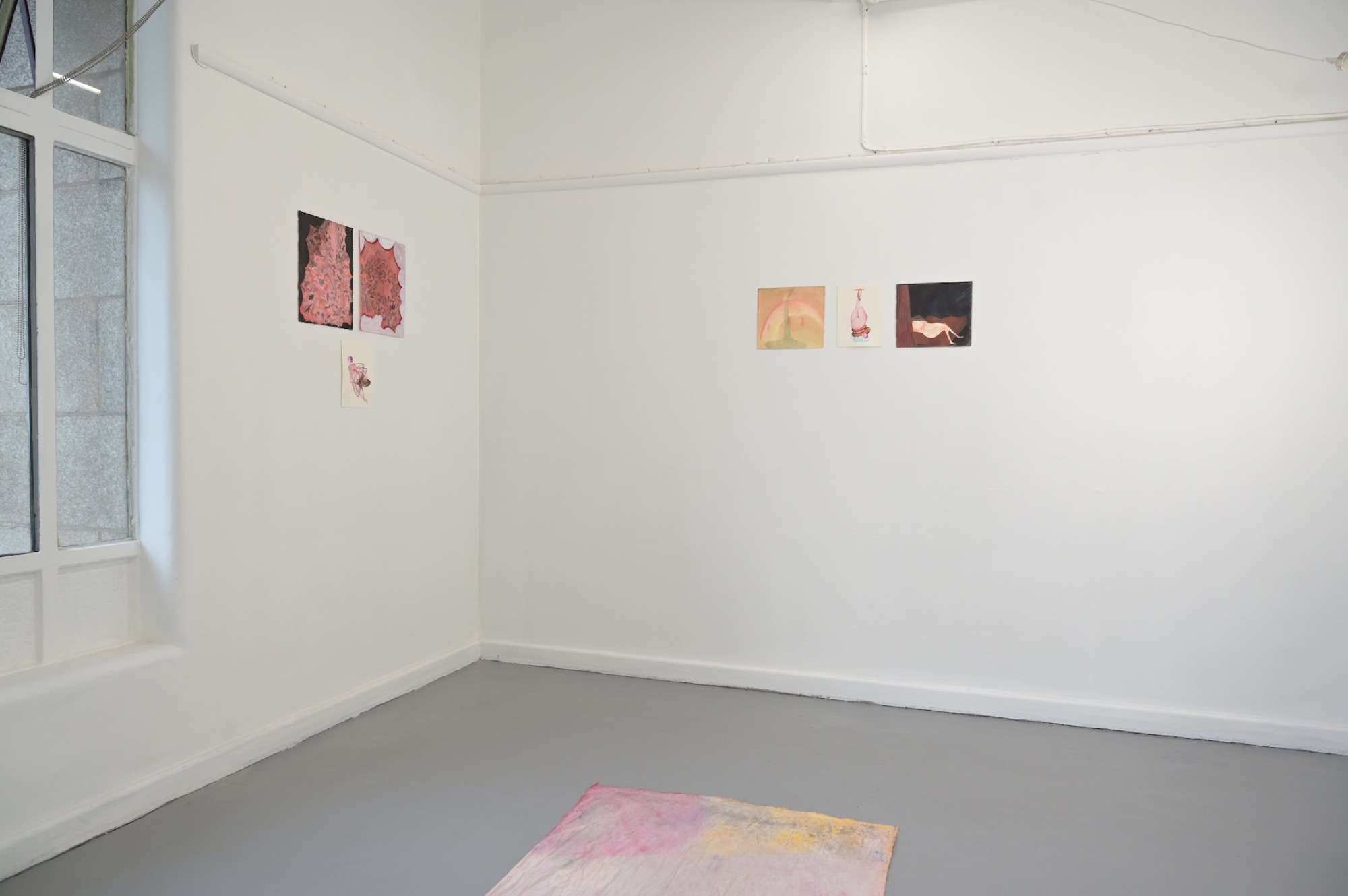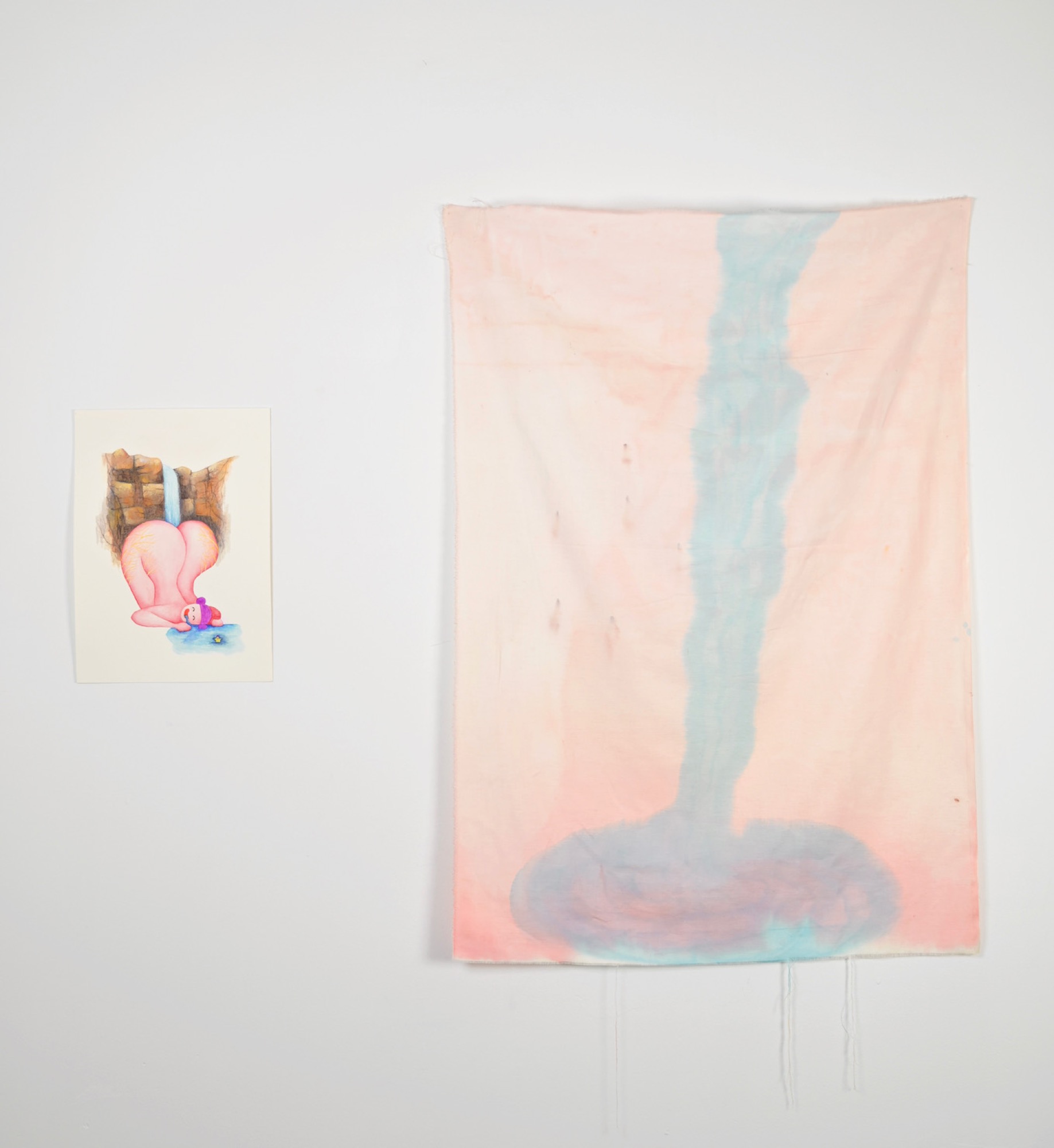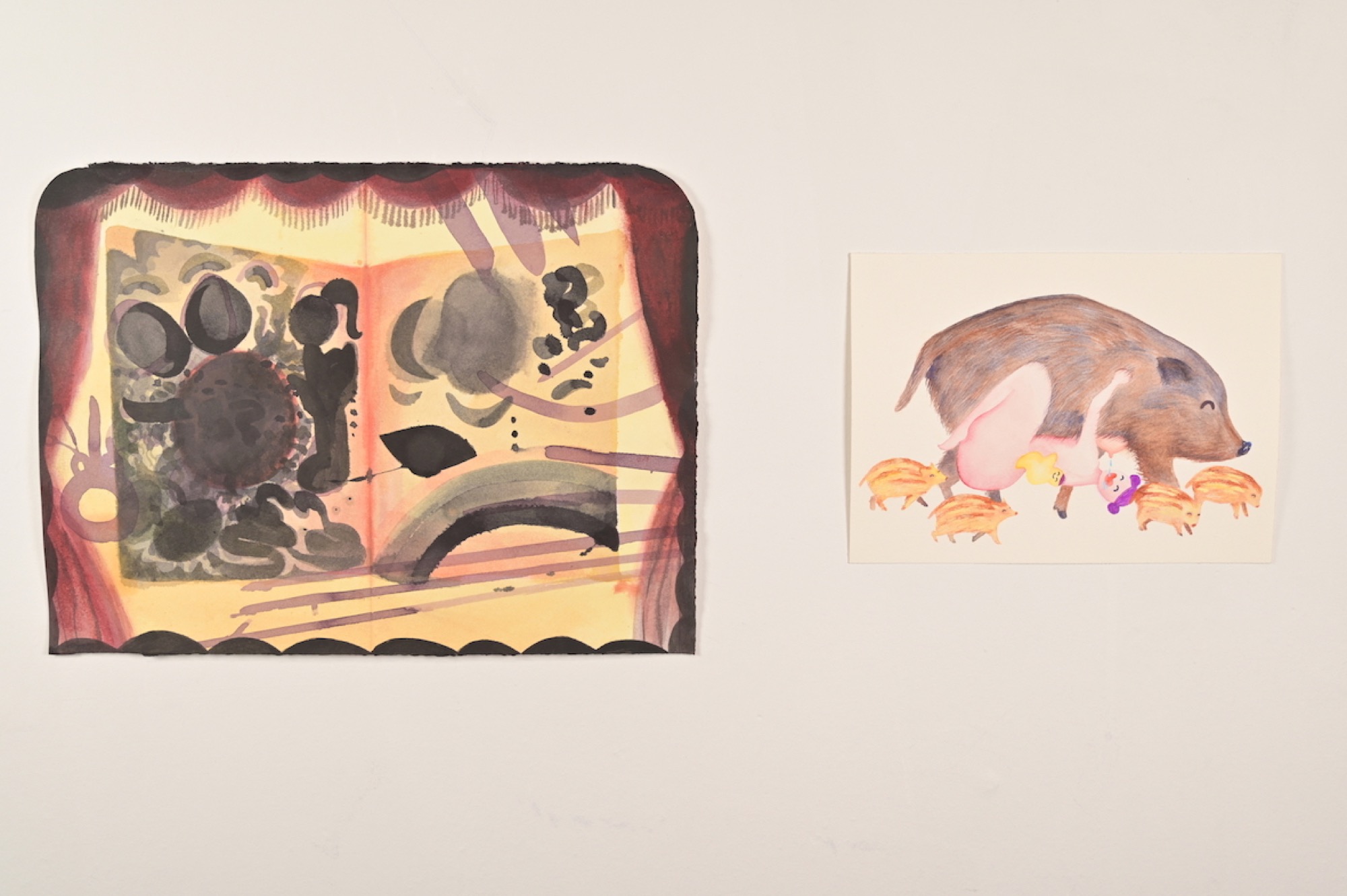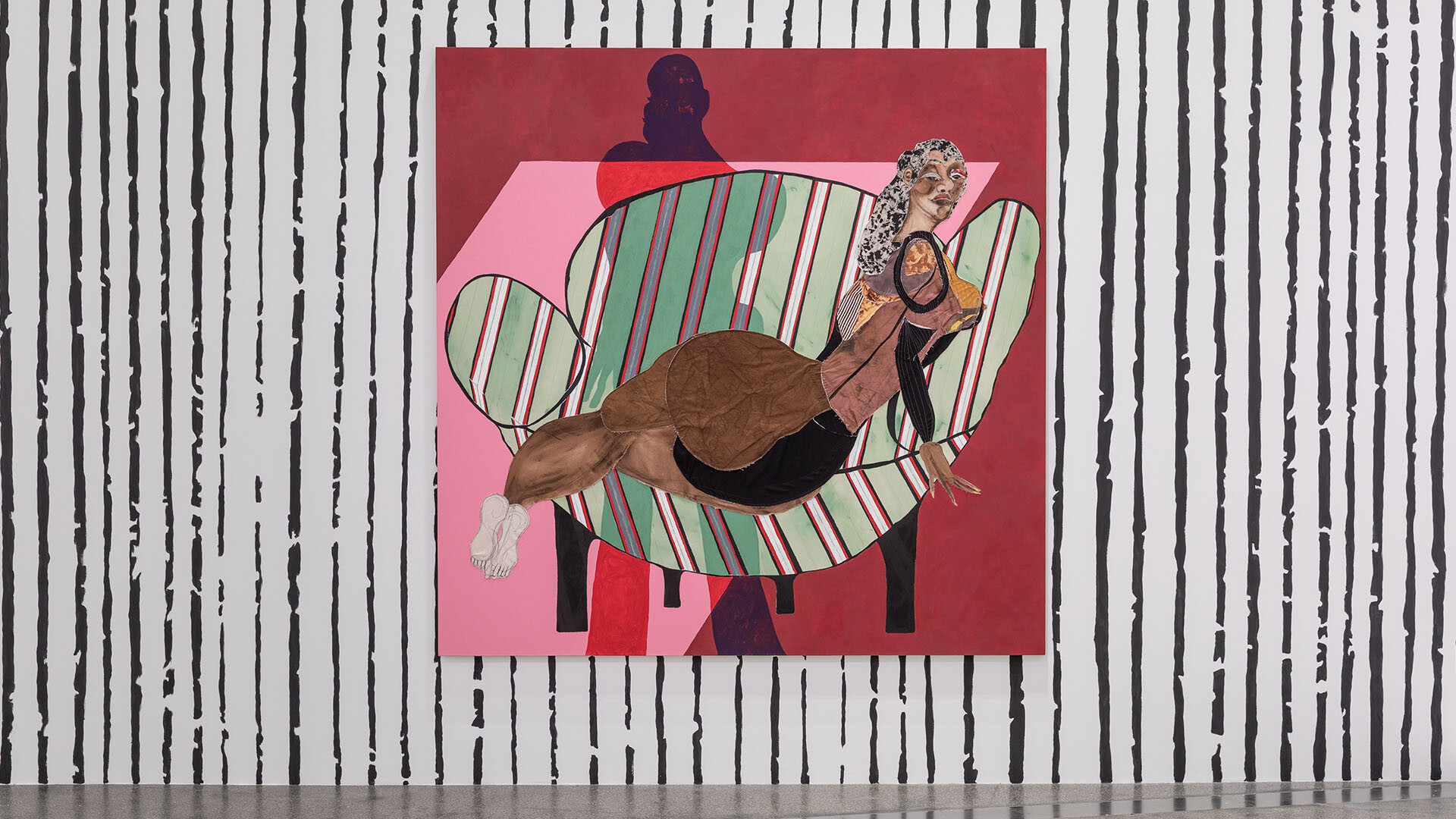Spring/Sprung
Amelia Winata
The first image one sees upon entering Spring/Sprung at Caves is Noriko Nakamura’s tiny painting, Magma, 2020. The small watercolour, just 18 by 25 cm, depicts a cartoon-like nude woman whose vagina doubles as an erupting volcano. Laying on her back, hot magma streams down her navel, between her breasts and across her thighs. Small fires have established themselves in her armpit and navel. Together with the spurting volcano, they contribute to a huge plume of dense smoke above. With her arms stretched above her head, her back arched and eyes closed with satisfaction, the woman is clearly in a state of sexual ecstasy, The volcano is orgasmic. The red magma doubles as menstrual blood and as a reminder of female reproduction. It is this conflation of sexuality and parenting that Nakamura takes as her central theme in the collection of watercolours that she presents as her part of Spring/Sprung. Nakamura’s representation teases out the binaries often imposed on women who choose motherhood. Nakamura’s mother is a sexual mother, not a MILF. There is a difference. She is not open to the gaze of her audience but, instead, is enclosed in her own bubble of pleasure.

The subtle but significant nuances between the subjects of erotica, sexuality and sensuality are fundamental to Spring/Sprung, a two-person exhibition with Nakamura and Israeli-born painter Inbal Nissim. Before moving to Melbourne two years ago, Nissim was producing oils on canvas and smaller scale ink paintings, the latter often in the format of artist books. For Spring/Sprung, Nissim has transposed ink to an almost exclusively abstract format that goes against the traditional use of ink as a medium for smaller, illustrative works. Nakamura, who has been active in the Melbourne art community for over a decade, is probably best known for her limestone sculptures, which she meticulously hand-carves. Since the birth of her daughter in 2018, she has been producing smaller watercolours, presumably because they are easier to make with an infant. Indeed, both Nissim and Nakamura have young children, and though Nissim’s works do not as explicitly address parenthood as Nakamura’s do, they operate as the corporeal counter to Nakamura’s representation of the mother.

It is not that the sexual mother has been excluded from art history but, rather, that she has always been a sexualised product of a hetero-normative male gaze—Flora in Botticelli’s Primavera, for example—which is catered to through the realistic depiction of the body and the longing expression of the female object looking out to her objectifying viewer. Each of Nakamura’s watercolours includes the same stylised female character. Nakamura describes her face as emoji-like—two arches for eyes and a red inverted arch for the mouth—which she has purposely painted in this way to deflect the possibility of the viewer’s sexualising gaze. Meanwhile, the only semi-figurative work that Nissim has in the exhibition—a female nude in a darkened landscape whose face is obscured by a tree trunk—is entirely unsexy insofar as the body seems deformed, with spindly short calves and an inelegant block of pigment as proxy for the body. Yet, the unbridled application of black and ox red to the paper is sensuous. The landscape and figure bleed into one another to produce a single plane of ink completely enmeshed in its paper support.

Nakamura and Nissim were introduced by Caves director Storm Gold for the purposes of this exhibition (Spring/Sprung was originally intended for the 2020 edition of Spring 1883, which has since been killed by the endless winter of COVID-19). Over the course of several months, the artists regularly conversed while producing works separately. The resulting dialogue between the two artists is, at times, totally uncanny. Take, for example, the pairing of Nakamura’s Don’t go Chasing Waterfalls (2020) with Nissim’s LABrINTO (2019) (all but one of Nissim’s pieces in the exhibition are titled LABrINTO). Nakamura’s painting depicts the same female character as Magma, only now she has her butt pointed up to a waterfall, against which she is pleasuring herself. Water spills out of her smiling mouth to a suggest a symbiosis of her body with nature. The puddle that pours from her mouth contains a small, smiling star-shaped figure—her child bathing with delight. Nissim’s LABrINTO, installed next to Nakamura’s, also presents an image of water. The artist uses similar pink and blue hues as Nakamura’s painting as well as the same stylisation of the liquid welled in a puddle at the bottom of the image. Indeed, a common trope in Spring/Sprung is liquidity—represented in images and also embodied in the artists’ use of watercolours and ink—which recalls a broader consideration of the relationship between gender and nature in the history of art.

It was in reference to Fritz Lang’s 1927 film Metropolis that Andreas Huyssen contested the construction of woman as a category of nature. Huyssen argue that women represented two threats to men: the virgin/mother and vixen. The first is represented by the virgin/mother, who intimidates the man for his inability to carry and give birth to children. In Metropolis, this Freudian lack is overcome when the inventor Rotwang creates a female robot, signifying man’s ability to finally create life without the need for women. The problem, then, is that the robot takes on the characteristic of the vixen, who seduces the workers into obeying her orders and, in turn, threatens the dominance of her “master” Frederson (Spoiler alert! she is burned at the stake in the end, and all order is restored). Huyssen argues that Metropolis represents modernity’s designation of technology as the domain of men, and nature the domain of women (epitomised by the scene of the virgin Maria leading children into the “pleasure gardens” of the Metropolis). This binary is based on the logic that women, as child-bearers, inherently internalise nature. Further compounding modernity’s damnation of women is the added argument that nature is unruly and unpredictable, while men are rational beings and, therefore, align with the image of the modernist machine. The Venn diagram of woman as either virgin or vixen and man as technology, of course, produces something like this: the purest woman is the virginal mother who is represented by nature and simultaneously at one with nature. In the final analysis, my theory is reinforced by recalling the age-old designation of nature as woman and maternal in the idiom “mother nature”. The mutual exclusivity of the virgin/vixen is expunged in Spring/Spring, where the mother exists in nature but also fucks nature.
Nature is the giver of sexual pleasure in Nakamura’s images. The viewer is reminded that the logic of taboo is not only a gendered phenomenon but one which is also culturally seated. Indeed, Nakamura’s various suggestions of bestiality, BDSM and the presence of the infant alongside the mother seem even more unsettling to the Western gaze. Most of her works are inflected with suggestions of the Japanese culture she grew up in. She references shunga, a form of erotic print produced in Japan between the 17th and 19th centuries, which often includes images of children, not as parts of the erotica but, instead, as signifiers of the domestic scene. I am also reminded of a set of early 20th century prints by Toraji Ishikawa, Ten Types of Female Nudes, currently on show in the NGV exhibition Japanese Modernism. Many of these erotic images feature pet cats, dogs or birds. In Nakamura’s work, this traditional imagery is augmented to fantastical ends. In Great Mother (2020) the mother rides on the undercarriage of an inoshishi (Japanese boar), feeding from its teat with her own child attached to her. Elsewhere, the mother lays on her back with her legs spread wide (Snakes, 2020). Three snakes are wrapped tightly around her body in an allusion to Kinbaku, a Japanese form of bondage. One snake, with its tongue extended, appears to be preparing for cunnilingus.

There is one sculptural work in Spring/Sprung—Nissim’s LABrINTO (2020)—which mediates the flow of the body around the space through movement and time. The work is really a long calico/ink painting but, placed in the middle of the main gallery floor, it encourages viewers to circle around it and squat to observe more closely. The linen has been stained with washed out black, yellow and pink ink, while traces of small figures (perhaps animals) are only just visible. The desire to touch the piece abounds, prompting me to recall Briony Fer’s discussion of Eva Hesse’s use of colour in her monochromes which, Fer says, was not only visual but also corporeal: “a touch of colour”. For LABrINTO, this impulse to feel is elicited firstly through the way the ink penetrates the linen, sinking into its thick weave and creating a wrinkled and stiff texture like what you might see in an over-starched bedsheet. Indeed, one cannot avoid the gendered cliché attached to the application of paint with a flowing quality. How could we forget, for example, the interpretation of Helen Frankenthaler’s colour fields as representations of menstruation? But it is precisely these clichés that Nakamura and Nissim—in their respective uses of watercolours and ink—so closely skirt towards but ultimately upend. And, if anything, the evocation of the sensual through sight is a riff on the phenomenological reading of (male) dominated American minimalism. With Minimalism, we are made to remember, sight gives rise to an awareness of the body in space. But what is this bodily awareness? Nissim completes this gap by arguing for the body as a repository of touch.

As a whole, Spring/Spring erases the logic that motherhood and sexuality are mutually exclusive. Aware that this binary is one with a deep-seated history of male dominance, Nakamura and Nissim have sought to produce work that not only denies the male gaze but also shuts it out of the equation. Here, the mother represents the biggest hazard to male fragility insofar as she confirms the double threat that is beaten down in Metropolis. In the dream of Metropolis, men find a way to beat down their sexual desire and to manage reproduction without women. But in Spring/Sprung woman reproduce all the while managing to get off. She is not only the giver of life, but, also, the giver of her own pleasure.
Amelia Winata is a Melbourne-based arts writer and PhD candidate in Art History at the University of Melbourne.


